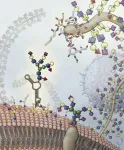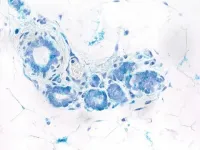In slow motion against antibiotic resistance
How novel therapeutics provide insight into bacteria membranes
2021-05-17
(Press-News.org) FRANKFURT. There are currently only a few synthetic agents that bind to and block the widespread membrane transport proteins, ATP-binding cassette transporters (ABC). Scientists at Goethe University and the University of Tokyo identified four of these macrocyclic peptides as models for a novel generation of active substances. They used methods for which the scientists involved are considered world leaders.
Thanks to deep sequencing, an extremely fast and efficient read-out procedure, the desired macrocyclic peptides could be filtered out of a "library" of macrocyclic peptides comprising trillions of variants (1 with 12 zeroes) - a number that exceeds the number of stars in the Milky Way. The fact that such an enormous amount exists at all is related to a novel procedure: By reprogramming the genetic code, amino acids can be used specifically as active components that are not otherwise used in the cell. In particular, their circular, closed structure distinguishes them from natural proteins. "Because these therapeutics are cyclic, they break down less rapidly in the cell," explains Robert Tampé, Director of the Institute of Biochemistry at Goethe University. "In addition, the ring-shaped active substances are restricted in their spatial structure, so they bind to the target molecule without major rearrangements." A third distinguishing feature makes macrocyclic peptides particularly attractive for scientists: When the active substances are produced, their building instructions are supplied as a "barcode". If certain therapeutics are selected from among a trillion synthetically produced ones, they carry their "name tags" with them, so to speak.
So what role do synthetic therapeutics play in antibiotic resistance in bacteria or multidrug resistance in tumour cells? What happens when they encounter the ATP-driven transport molecule that is responsible for resistance by carrying the chemotherapeutic agents out of the cell? In a nutshell: The drugs block the transporter by binding to it. This can happen at the beginning or at the end of a transport process, when the transporter is in a resting state. However, since the scientists can slow down the transport process so that it is carried out in slow motion, they can identify the agents that "enter" in the middle of the transport process and "hold" the membrane protein in its respective position. In this way, the researchers gain an insight into the choreography of the transport process as if through the images of a film strip.
These insights have already led to a "paradigm shift" in science, as Tampé explains: "Until now, we have assumed that ATP hydrolysis (note: an energy-releasing splitting process) provides the energy for transport through the membrane. However, this is only indirectly the case. It is the event of the binding of the ATP molecule that pushes substances out of the cell. The energy of hydrolysis, on the other hand, is used to return the ABC transporter to its initial state." The research groups at Goethe University and the University of Tokyo are convinced that these and other insights into membrane processes will point to the development of future medicines.
Basic research on cellular membranes and membrane proteins already has a long tradition in Frankfurt. Robert Tampé elucidated essential mechanisms of ATP-driven transport proteins and cellular machinery of adaptive immune response and quality control, which together with this new publication can provide approaches for applied drug research. Tampé was head of the Collaborative Research Centre "Transport and Communication across Biological Membranes" (SFB 807) which expired at the end of 2020. Meanwhile the concept for a new research centre on highly dynamic processes related to protein networks and machineries in cellular membranes is already under development. In the long term, the research results should reveal new possibilities for the therapy of molecular diseases, infections and cancer.
INFORMATION:
Images for download: http://www.uni-frankfurt.de/101026220
(Graphic: Robert Tampé, Institute for Biochemistry, Biocentre, Goethe University Frankfurt)
Caption: Synthetic therapeutics for antibiotic resistance in bacteria or multidrug resistance in tumour cells can block ATP-driven transport proteins that carries chemotherapeutics out of the cell
ELSE PRESS RELEASES FROM THIS DATE:
2021-05-17
In a surprise find, scientists have discovered sugar-coated RNA molecules decorating the surface of cells.
These so-called "glycoRNAs" poke out from mammalian cells' outer membrane, where they can interact with other molecules. This discovery, reported May 17, 2021, in the journal Cell, upends the current understanding of how the cell handles RNAs and glycans.
"This was probably the biggest scientific shock of my life," says study author END ...
2021-05-17
PULLMAN, Wash. -- Washington State University researchers have developed an innovative way to convert plastics to ingredients for jet fuel and other valuable products, making it easier and more cost effective to reuse plastics.
The researchers in their reaction were able to convert 90% of plastic to jet fuel and other valuable hydrocarbon products within an hour at moderate temperatures and to easily fine-tune the process to create the products that they want. Led by graduate student Chuhua Jia and Hongfei Lin, associate professor in the Gene and Linda Voiland School of Chemical Engineering and Bioengineering, they report on their work in the journal, ...
2021-05-17
What The Study Did: Researchers assessed the feasibility of using positive behavior supports to promote the use of face coverings in school-aged children with autism spectrum disorders and/or attention-deficit/hyperactivity disorder (ADHD) attending a summer program during the COVID-19 pandemic.
Authors: Benjamin Aaronson, Ph.D., of the University of Washington in Seattle, is the corresponding author.
To access the embargoed study: Visit our For The Media website at this link https://media.jamanetwork.com/
(doi:10.1001/jamanetworkopen.2021.10281)
Editor's Note: The article includes conflicts of interest disclosures. Please see the article for additional information, including other authors, author ...
2021-05-17
What The Study Did: Hospital discharge rates, hospitalization outcomes and demographic factors were examined among U.S. patients with ischemic stroke before and during the COVID-19 pandemic.
Authors: Adam de Havenon, M.D., of the University of Utah in Salt Lake City, is the corresponding author.
To access the embargoed study: Visit our For The Media website at this link https://media.jamanetwork.com/
(doi:10.1001/jamanetworkopen.2021.10314)
Editor's Note: The article includes conflict of interest and funding/support disclosures. Please see the article for additional information, including other authors, author contributions and affiliations, conflict of interest ...
2021-05-17
What The Study Did: Online search data were used to assess changes in home birth information seeking across the United States and United Kingdom during the COVID-19 pandemic.
Authors: Christina N. Schmidt, B.S., of the University of California, San Francisco, is the corresponding author.
To access the embargoed study: Visit our For The Media website at this link https://media.jamanetwork.com/
(doi:10.1001/jamanetworkopen.2021.10310)
Editor's Note: Please see the article for additional information, including other authors, author contributions and affiliations, conflict of interest and financial disclosures, and funding and support.
INFORMATION:
Media advisory: The full study is linked to this news release.
Embed this link to provide your readers free access ...
2021-05-17
Early diagnosis and improvement of breast cancer treatments have reduced breast cancer mortality in recent years, with survival rates reaching 85% today. In spite of these data, breast cancer was still the most frequently diagnosed tumour in the world in 2020, mainly due to increased population screening and social factors such as ageing. RANK protein plays a key role in the development of these tumours. Located in the membrane of cells, when it binds to its partner RANKL, it sends signals that stimulate the development of the mammary gland. When these proteins do not work properly, breast cells begin to divide and multiply ...
2021-05-17
Mitochondria - the 'batteries' that power our cells - play an unexpected role in common diseases such as type 2 diabetes and multiple sclerosis, concludes a study of over 350,000 people conducted by the University of Cambridge.
The study, published today in Nature Genetics, found that genetic variants in the DNA of mitochondria could increase the risk of developing these conditions, as well influencing characteristics such as height and lifespan.
There was also evidence that some changes in mitochondrial DNA were more common in people with Scottish, Welsh or Northumbrian genetic ancestry, implying that mitochondrial DNA and nuclear DNA (which accounts for 99.9% of our genetic make-up) interact with each other.
Almost ...
2021-05-17
Scientists have succeeded in dating some of the oldest stars in our galaxy with unprecedented precision by combining data from the stars' oscillations with information about their chemical composition.
The team led by researchers at the University of Birmingham, surveyed around a hundred red giant stars, and were able to determine that some of these were originally part of a satellite galaxy called Gaia-Enceladus, which collided with the Milky Way early in its history.
The results, published in Nature Astronomy, revealed that the group of stars surveyed all have similar ages, or are slightly younger than the majority of the stars known to have started their lives within the Milky Way. This corroborates existing theories suggesting the Milky Way had already started forming a significant ...
2021-05-17
In the largest genetic study of bipolar disorder to date, researchers have identified 64 regions of the genome containing DNA variations that increase risk of bipolar disorder - more than double the number previously identified.
The research team also found overlap in the genetic bases of bipolar disorder and other psychiatric disorders. Furthermore, the study supports a role of sleep habits, alcohol, and substance usage in the development of bipolar disorder, although further research is needed to confirm these findings. The study results are published May 17 in Nature Genetics.
Bipolar disorder, a complex psychiatric disorder characterized by recurrent episodes of severely high and low mood, affects an estimated 40 to 50 million people worldwide. It typically begins ...
2021-05-17
Researchers from the Francis Crick Institute, Royal Marsden, UCL and Cruces University Hospital have found that cells from different parts of kidney tumours behave differently, and surprisingly, cells within the centre of a tumour are the most aggressive and have the highest chance of spreading around the body.
Cancers can spread to other parts of the body, with cells taking hold as secondary tumours which make the disease much harder to treat. Understanding the mechanics of this spread, a process called metastasis, could lead to new treatments that block this migration.
In their multidisciplinary study ...
LAST 30 PRESS RELEASES:
[Press-News.org] In slow motion against antibiotic resistance
How novel therapeutics provide insight into bacteria membranes


